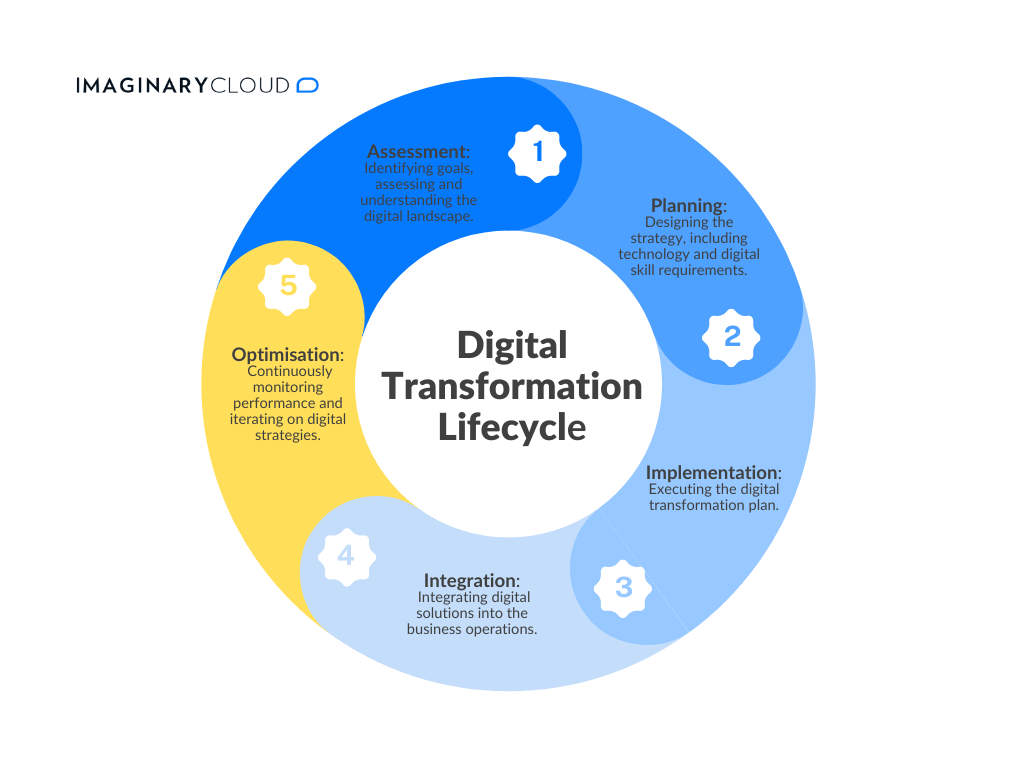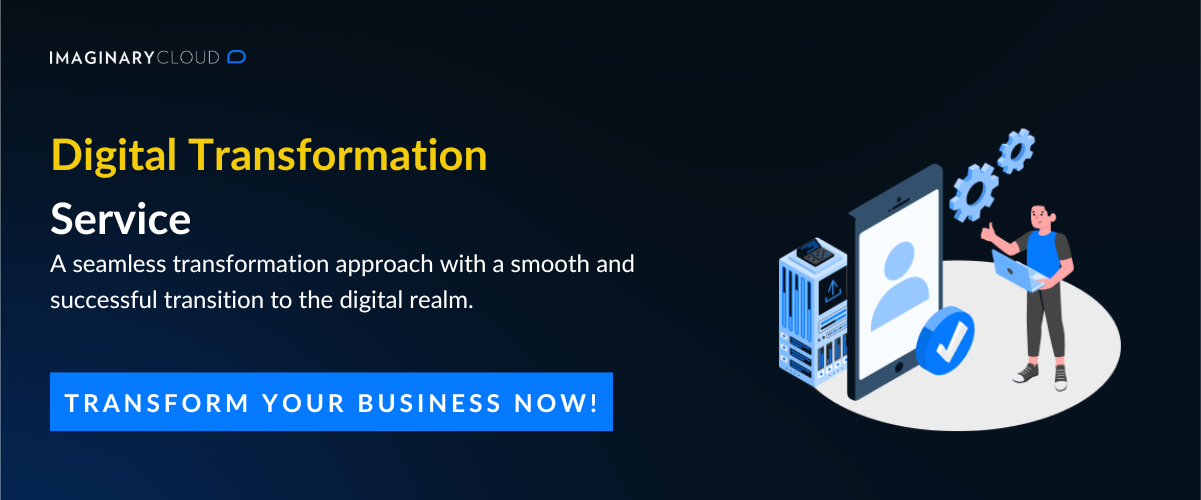Ever wondered what it's like to give your business a tech makeover? That's what diving into digital transformation is all about. It's not just about jumping on the latest tech trend. It's a journey—a marathon, really—that can fundamentally change how your business operates and delights your customers.
But starting this journey without a clear map can feel like wandering in the dark. So, if you're curious about how to turn your business into a lean, mean digital machine, you've come to the right place. This article is your guide through the digital transformation lifecycle, from the first steps to the continuous improvements that keep you ahead of the game. Let's get started!
Table of Contents
What is the Digital Transformation Lifecycle?
Each Stage of the Digital Transformation Lifecycle Explained
Making the Digital Transformation Lifecycle Successful
Evaluating Your Digital Transformation Strategy
Final Thoughts
What is the Digital Transformation Lifecycle?
The digital transformation lifecycle is a structured approach businesses follow to integrate digital technology into all operations. It encompasses several stages, each critical for ensuring the transformation efforts are strategic, coherent, and aligned with the organisation's objectives.
This lifecycle enables businesses to transition from traditional operations to digital-first strategies systematically, with global spending on digital transformation expected to reach $3.4 trillion by 2026, highlighting the scale and importance of these initiatives.
The stages of the digital transformation lifecycle are:
- Assessment
- Planning
- Implementation
- Integration
- Optimisation
Each Stage of the Digital Transformation Lifecycle Explained
Navigating the digital transformation lifecycle is like embarking on a grand adventure. Each stage is a step towards reinventing your business, making it more resilient, agile, and customer-focused. Let's break down these stages, shall we?
Assessment: Where Are We Now?
Think of this as your digital check-up. Before you can sprint, you need to know your starting line. This stage is all about taking a hard look at your current tech setup, processes, and how digital your business is. It's the stage to detect gaps and opportunities and plot your moves.
Planning: Charting the Course
Now that you know where you stand, it's time to map out where you want to go. This stage is about strategy—defining your digital transformation objectives, timelines, and the resources you'll need to make it happen. It's your game plan detailing how you'll tackle each aspect of your transformation.
Interestingly, companies that excel in digital transformation are 1.5 times more likely to have a clear, enterprise-wide technology architecture strategy. This highlights the importance of thorough planning in the success of your digital journey.
Implementation: Making It Happen
You've got your plan, and now it's time to execute. Whether rolling out new software, digitising your customer service, or automating processes, this stage is all about action. It's exciting, but also where challenges often crop up—technical hiccups, resistance to change, you name it.
Company's digital transformations improve performance and are sustainable in the long term. This underscores the need for a focused, well-executed implementation that addresses both the technical and human sides of the equation.
Integration: Bringing It All Together
If implementation is about getting new digital tools and processes up and running, integration is about making them part of the fabric of your business. This means ensuring new systems work seamlessly with existing ones and that your team is on board and proficient with these new tools. It's a critical step to avoid silos and ensure your digital transformation adds value across the board.
Effective integration can increase productivity by reducing bottlenecks and improving workflows. This highlights the transformative power of successful integration in achieving digital transformation goals.
Optimisation: Continuous Improvement
The optimisation stage is about continually refining and improving your digital tools and processes. It's an ongoing cycle of feedback, learning, and tweaking to ensure your digital initiatives deliver the intended value and keep pace with technological advancements.
Notably, 85% of executives said their company has significantly or somewhat accelerated the implementation and adoption of technologies, showing the critical role of continuous improvement in digital transformation success.

Making the Digital Transformation Lifecycle Successful
Embarking on a digital transformation journey is no small feat. It requires careful planning, execution, and ongoing management to ensure success. Drawing from the experiences of industry leaders and the latest research, here are some best practices that can guide businesses through their digital transformation endeavours.
Secure Executive Sponsorship and Cross-Departmental Collaboration
Leadership buy-in is crucial for driving digital transformation efforts forward. Executives provide the necessary resources and set a vision aligning the entire organisation towards common goals. Companies with strong senior management support for digital initiatives are more likely to report successful transformations.
Moreover, digital transformation impacts all business areas, making cross-departmental collaboration essential. Encouraging open communication and teamwork across departments ensures a unified approach to transformation efforts.
Focus on Customer-Centric Approaches
Putting customers at the heart of your digital transformation strategy is key. This means understanding their needs, preferences, and behaviours and using these insights to shape your digital initiatives. Companies that prioritise customer experience in their digital transformation are more likely to outperform their competitors.
Invest in Employee Training and Change Management
Digital transformation also means cultural transformation. Preparing your workforce for the changes ahead minimises resistance and enhances adoption. This involves training employees on new technologies and processes and fostering a culture of innovation and continuous learning.
Companies that invest in employee development and change management are 2.5 times more likely to succeed in their digital transformation efforts.
Regularly Review and Adapt the Digital Transformation Strategy
The digital landscape is constantly evolving, and so should your digital transformation strategy. Regularly reviewing and adjusting your approach based on new technologies, market trends, and business outcomes ensures that your transformation efforts remain relevant and effective.
Leverage Data and Analytics for Informed Decision Making
Data is a critical asset in the digital age. Leveraging data analytics allows businesses to make informed decisions, optimise operations, and personalize customer experiences. Companies using data analytics in their digital transformation strategies can significantly improve their operational efficiency and customer satisfaction. Organisations using analytics are five times more likely to make faster decisions.

Evaluating Your Digital Transformation Strategy
Evaluating your digital transformation strategy is crucial for ensuring that your efforts align with your business objectives and are poised to deliver the intended outcomes.
Key Performance Indicators (KPIs)
Establish clear KPIs reflecting short-term wins and long-term objectives. A study by McKinsey found that companies with successful digital transformations have set clear Key Performance Indicators (KPIs) that reflect both short-term wins and their strategic long-term objectives.
Feedback Loops
Implement regular feedback mechanisms from all stakeholders, including employees, customers, and partners. Gartner emphasises the role of continuous feedback, with 95% of leading companies using customer feedback to shape their digital strategies.
Benchmarking
Comparing your progress and outcomes with industry benchmarks and competitors can provide a broader context for evaluating your digital transformation strategy. This can help identify areas where you're leading or lagging and uncover best practices or emerging trends you may have overlooked.
Technology and Market Trends
Stay abreast of emerging technologies and market trends. The digital landscape evolves rapidly, and your strategy should be flexible enough to adapt to these changes.
Final Thoughts
Embarking on a digital transformation journey is crucial for businesses seeking to excel in the digital era. It involves a strategic overhaul from the ground up, focusing on integrating new technologies and reshaping customer interactions. Success hinges on strong leadership, agility, and a relentless focus on the customer.
Ready to navigate the complexities of digital transformation and unlock your business's potential? Visit our Digital Transformation Service page and contact Imaginary Cloud for guidance through the transformative process, ensuring your business adapts and thrives. Let's start this journey together.



